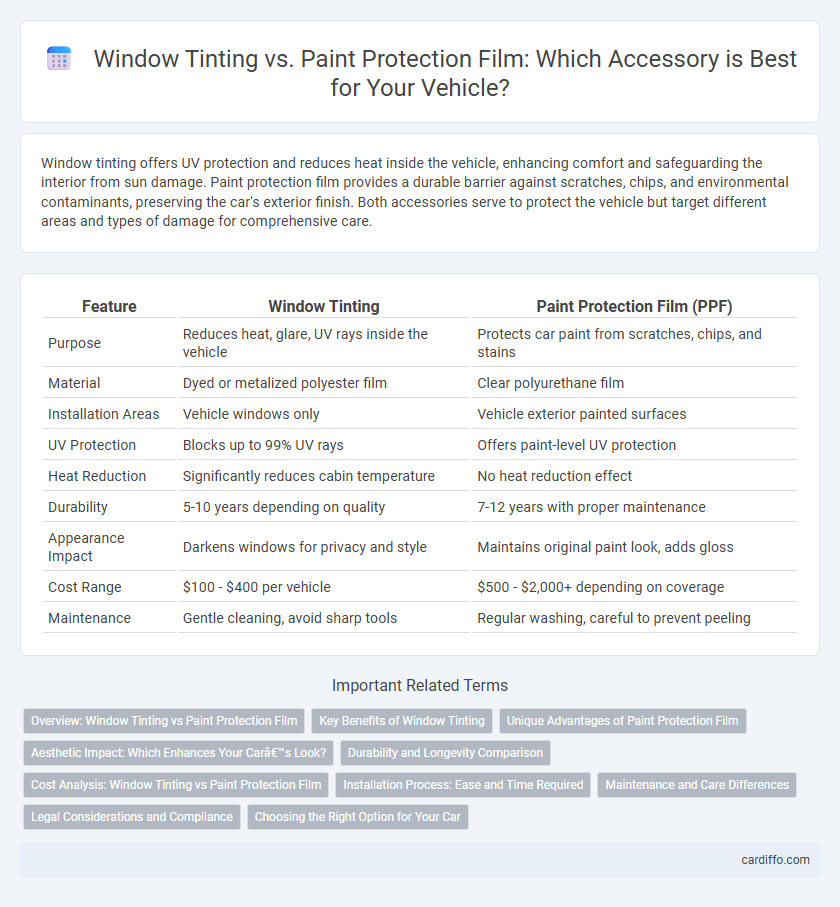Window tinting offers UV protection and reduces heat inside the vehicle, enhancing comfort and safeguarding the interior from sun damage. Paint protection film provides a durable barrier against scratches, chips, and environmental contaminants, preserving the car's exterior finish. Both accessories serve to protect the vehicle but target different areas and types of damage for comprehensive care.
Table of Comparison
| Feature | Window Tinting | Paint Protection Film (PPF) |
|---|---|---|
| Purpose | Reduces heat, glare, UV rays inside the vehicle | Protects car paint from scratches, chips, and stains |
| Material | Dyed or metalized polyester film | Clear polyurethane film |
| Installation Areas | Vehicle windows only | Vehicle exterior painted surfaces |
| UV Protection | Blocks up to 99% UV rays | Offers paint-level UV protection |
| Heat Reduction | Significantly reduces cabin temperature | No heat reduction effect |
| Durability | 5-10 years depending on quality | 7-12 years with proper maintenance |
| Appearance Impact | Darkens windows for privacy and style | Maintains original paint look, adds gloss |
| Cost Range | $100 - $400 per vehicle | $500 - $2,000+ depending on coverage |
| Maintenance | Gentle cleaning, avoid sharp tools | Regular washing, careful to prevent peeling |
Overview: Window Tinting vs Paint Protection Film
Window tinting primarily reduces heat, glare, and UV rays, enhancing interior comfort and protecting against sun damage. Paint protection film offers a durable barrier against scratches, chips, and environmental contaminants, preserving the vehicle's exterior finish. Both accessories serve distinct protective functions, with window tinting focused on glass and paint protection film targeting the vehicle's body.
Key Benefits of Window Tinting
Window tinting reduces heat and glare inside vehicles by blocking up to 99% of UV rays, enhancing comfort and protecting interior surfaces from fading and cracking. It improves privacy and security by limiting visibility from outside, deterring theft and vandalism. Energy efficiency is boosted as tinted windows reduce the need for air conditioning, leading to lower fuel consumption and cost savings.
Unique Advantages of Paint Protection Film
Paint Protection Film (PPF) offers superior resistance against scratches, stone chips, and environmental contaminants, preserving the vehicle's original paint quality more effectively than window tinting. Unlike window tinting, PPF provides a self-healing surface that repairs minor abrasions over time, maintaining a smooth and clear finish. Its transparent nature ensures full color retention while delivering robust protection, making it a preferred choice for long-term vehicle preservation.
Aesthetic Impact: Which Enhances Your Car’s Look?
Window tinting enhances a car's aesthetic by providing a sleek, uniform appearance and reducing glare while complementing the vehicle's overall design. Paint protection film preserves the original paint finish, maintaining the car's showroom quality by preventing scratches and chips without altering its color or texture. Choosing between the two depends on whether you prioritize the subtle darkened appearance from tinting or the invisible safeguard offered by paint protection film to enhance your car's look.
Durability and Longevity Comparison
Window tinting offers moderate durability, generally lasting 5 to 10 years depending on the quality of the film and environmental exposure, while paint protection film (PPF) provides superior protection with a lifespan of 5 to 15 years due to its thicker, impact-resistant material. PPF resists scratches, chips, and UV damage more effectively than window tinting, which primarily reduces glare and heat but is more susceptible to bubbling and fading over time. Choosing PPF ensures enhanced longevity and robust defense for vehicle surfaces, making it a more durable option compared to window tinting.
Cost Analysis: Window Tinting vs Paint Protection Film
Window tinting generally costs between $100 and $400 depending on vehicle size and tint quality, offering an affordable option for UV protection and glare reduction. Paint protection film (PPF) ranges from $1,000 to $3,500, reflecting its durable, impact-resistant properties that safeguard against scratches and chips. Choosing between window tinting and PPF depends on budget constraints and desired protection level, with tinting providing lower upfront costs and PPF delivering comprehensive surface defense.
Installation Process: Ease and Time Required
Window tinting installation typically takes one to two hours and involves carefully applying a thin film to the interior glass surface, requiring precision but minimal tools. Paint protection film (PPF) installation is more complex and time-consuming, often taking four to eight hours due to the need for exact alignment on exterior vehicle surfaces and intricate trimming. The ease of window tinting makes it a quicker option for protection, while PPF demands professional expertise to ensure a flawless, durable finish.
Maintenance and Care Differences
Window tinting requires regular cleaning with a soft cloth and mild, ammonia-free soap to prevent discoloration and bubbling, while avoiding abrasive materials that can scratch the film. Paint protection film demands more meticulous care, including routine washes with specialized automotive shampoos and periodic application of recommended sealants to maintain its clarity and adhesive properties. Both accessories benefit from avoiding high-pressure washers near edges to extend their lifespan and effectiveness.
Legal Considerations and Compliance
Window tinting and paint protection film must comply with specific state regulations to avoid legal penalties, as tint darkness and reflectivity levels are often strictly defined by law. Paint protection film generally faces fewer restrictions but should still meet highway visibility and safety standards to ensure compliance. Understanding local Vehicle Code requirements is crucial for legally installing either accessory without risking fines or vehicle inspection failures.
Choosing the Right Option for Your Car
Window tinting enhances privacy and reduces heat by blocking UV rays, making it ideal for drivers seeking comfort and sun protection. Paint protection film offers a durable shield against scratches, stone chips, and environmental damage, preserving the vehicle's paint integrity. Selecting between window tinting and paint protection film depends on whether you prioritize interior temperature control and privacy or exterior paint preservation.
Window tinting vs paint protection film Infographic

 cardiffo.com
cardiffo.com